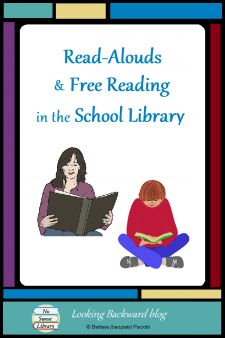 School Librarians love books and tend to be prolific readers. One reason we became School Librarians was to share our joy of reading with others. Any elementary School Librarian can tell you that an effective way to ‘hook’ students into reading is to read a story aloud.
School Librarians love books and tend to be prolific readers. One reason we became School Librarians was to share our joy of reading with others. Any elementary School Librarian can tell you that an effective way to ‘hook’ students into reading is to read a story aloud.
Young students never seem to tire of read-alouds, but many folks may think once students move beyond the elementary years, their fascination with read-alouds dissipates, but I can assure you that secondary students love them, too!
OLDER STUDENTS ENJOY READ-ALOUDS!
When I returned to education after a ‘mom’ hiatus I taught in an alternative high school. It was truly one of the most rewarding experiences of my life. The 15-19 year-old students in my school were “at-risk” of not graduating high school for a variety of reasons that made for poor performance in the regular classroom:
- Poor reading or math skills, some as low as 2nd grade
- Jobs to help support their family that kept them up late or missing days
- Extended stay in a hospital for severe illness/accident or in rehab for addiction to drugs/alcohol
- Lack of interest in or depression about the regular classroom, including social trauma
I learned early on that many of these kids had severely dysfunctional parents, and many never had a parent read to them as a child. One of their happiest memories was an elementary school teacher or librarian reading aloud to them. Each teacher had an Advisory of 8-10 students that met daily, so I introduced my Advisory to books my own children had enjoyed and that these students had probably never heard.
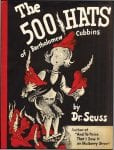 The first book I read aloud was an early Dr. Seuss book, The 500 Hats of Bartholomew Cubbins, because I felt the theme of the story—perseverance in spite of criticism and intimidation—would inspire these kids. It was such a hit that I reread it each year to my Advisory, and even though some had heard the story before (we had our Advisory kids until they graduated) they loved hearing it again. I also read aloud other topical Dr. Seuss and Caldecott titles, almost all of which generated fascinating discussions among these high school students. That experience convinced me of the simplified presentation of complex issues through children’s books, and I continue to use them as a middle school librarian, to equal success.
The first book I read aloud was an early Dr. Seuss book, The 500 Hats of Bartholomew Cubbins, because I felt the theme of the story—perseverance in spite of criticism and intimidation—would inspire these kids. It was such a hit that I reread it each year to my Advisory, and even though some had heard the story before (we had our Advisory kids until they graduated) they loved hearing it again. I also read aloud other topical Dr. Seuss and Caldecott titles, almost all of which generated fascinating discussions among these high school students. That experience convinced me of the simplified presentation of complex issues through children’s books, and I continue to use them as a middle school librarian, to equal success.
READ -ALOUDS AS PART OF SCHOOL LIBRARY LESSONS
 A particular middle school read-aloud success is during my 6g Multicultural Cinderella lesson. This collaborative co-taught lesson is designed to illustrate plot elements using the original Perrault Cinderella story as an exemplar. The 6g ELA Teacher introduces each plot element, and I, the School Librarian, read the associated story segment. While most students are familiar enough with Cinderella, many have never heard the original story. Though abbreviated for time, the read-aloud had students rapt with attention!
A particular middle school read-aloud success is during my 6g Multicultural Cinderella lesson. This collaborative co-taught lesson is designed to illustrate plot elements using the original Perrault Cinderella story as an exemplar. The 6g ELA Teacher introduces each plot element, and I, the School Librarian, read the associated story segment. While most students are familiar enough with Cinderella, many have never heard the original story. Though abbreviated for time, the read-aloud had students rapt with attention!
For the follow up activity students choose a multicultural Cinderella picture book on their table and, in pairs, read it to compare and contrast various cultural elements with the original story. The group discussion afterward emphasized to me that, not only do students enjoy being read to, but the combination of read-aloud and self-reading increases comprehension of concepts.
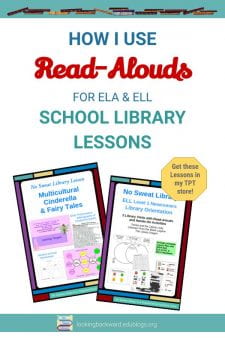 Read-alouds are particularly powerful with ESL/ELL students, who need to hear English spoken in a fluid manner to fully grasp the rhythm and flow of their new language. My Newcomer ELLs experience read-alouds for their first 3 library visits of the school year, all designed to make them comfortable with me and with using the school library.
Read-alouds are particularly powerful with ESL/ELL students, who need to hear English spoken in a fluid manner to fully grasp the rhythm and flow of their new language. My Newcomer ELLs experience read-alouds for their first 3 library visits of the school year, all designed to make them comfortable with me and with using the school library.
I also read aloud every week to our lowest-reading-level SpEd students who struggle with comprehension. Their teacher tells me what they are studying that week and I choose a story to support the subject area classroom activity. This wide range of read-alouds stimulates these students to explore the subject on their own, especially since I always pull a few fiction and/or non-fiction books on the topic for them to browse and check out.
PUT FREE READING INTO LIBRARY VISITS
Our middle school ELA teachers all have classroom libraries, but they don’t compete with a good School Library. No matter how spacious a classroom, a teacher can only stock a few hundred books for her students; even a small middle school library can offer several thousand current Fiction books. My ELA teachers understand the difference, so that is why they schedule regular library visits every other week throughout the year.
We discovered that 10 minutes of reading at the start of each class period is not enough “free reading”. For students who have never had regular free reading, giving them 10 minutes a day to read is a great way to begin, but it can’t be the end goal. Ten minutes isn’t long enough to truly become engaged in a story: prolific readers want to read longer, and reluctant readers just want to get through the time, often jumping from one book to another and never finishing any of them.
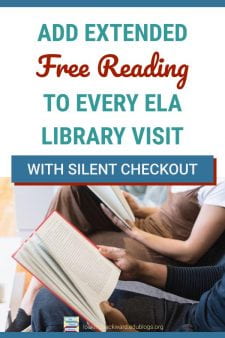 To really build readers we give students a 30-minute time period to become immersed in a story. When ELA teachers bring students to the library every other week for book return/checkout I occasionally have a lesson, but it’s a very small portion of the 50-minute period. Students always have 7-10 minutes to browse for books, and then sit down to read for the rest of the class period. During the last 10-15 minutes of the period I go to a couple tables at a time, signaling students it’s their turn to check out. This orderly checkout preserves the quiet reading atmosphere.
To really build readers we give students a 30-minute time period to become immersed in a story. When ELA teachers bring students to the library every other week for book return/checkout I occasionally have a lesson, but it’s a very small portion of the 50-minute period. Students always have 7-10 minutes to browse for books, and then sit down to read for the rest of the class period. During the last 10-15 minutes of the period I go to a couple tables at a time, signaling students it’s their turn to check out. This orderly checkout preserves the quiet reading atmosphere.
With a longer reading time, students become involved in the stories, continue to read on their own, and finish their books faster. Some students decide after a few minutes they don’t like the book they’ve chosen, and they still have time to find a new one and get started reading it. ELA teachers also provide a 30-minute reading time in the classroom during the interim week between library visits. The success of this strategy became evident to us with improved word recognition and reading comprehension, and we raised State Reading Test Scores. Interestingly, one year our district insisted on using the first 10 minutes of ELA periods for reading, but before the end of the first semester our ELA teachers realized it was a disaster, so we abandoned it and went back to our tried-and-true method with greater success.
My experiences as a high school teacher of at-risk students and a middle school librarian has convinced me that, no matter the grade level you teach, you can engage students with the power of reading using a combination of read-alouds and free reading time!
![]()
| You can find my Multicultural Cinderella lesson and my ELL 3-visit Library Orientation lesson in NoSweat Library Lessons, my TeachersPayTeachers store. | |
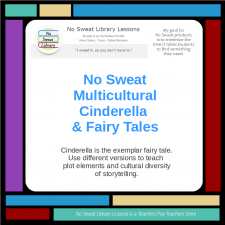 |
 |



The clear message is to read aloud at any age!